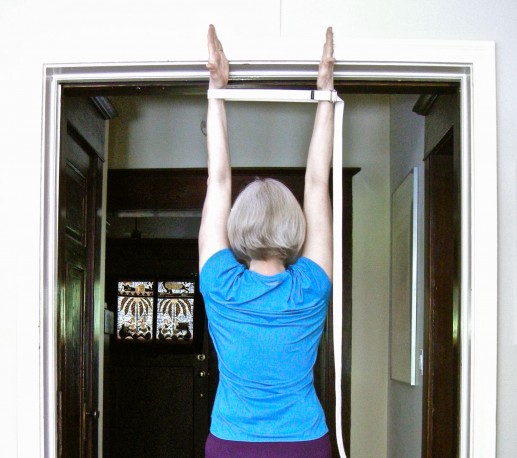The most yogic use for a doorway, real or metaphorical, would surely be to come and go mindfully, knowing when you’re on one side, when you’re in the middle, and when you’ve passed through.
But doorways also have yogic uses that are far more physical.
You can, for instance, use a doorway to get a deep stretch in your shoulders and upper chest.
While you’re at it, you can also learn to strengthen the work in your arms, knowledge which will stand you in good stead in any pose that demands strong arms and an open chest, say, chair pose, warrior III or full arm balance.
As a break from desk work, the doorway stretch makes a perfect Five-Minute Yoga Challenge to release your shoulders and clear your mind. In a longer practice, do it early. That way you’ll benefit from the opening when you do other poses.
Here’s how:
Make a loop in a strap, slightly less than shoulder width, and put the strap around your wrists.
Find a doorway that is low enough that when you take your hands up, you can brace the little finger side of your hand against the top of the doorway. If height is an issue, try standing on a small plastic stool, or on two wood bricks. (Put a sticky mat under the bricks so they don’t slip.)
Straighten your arms completely. If you can’t straighten your arms, make the loop in your strap bigger, so your arms can be wider apart.
Now bring your arms up and stand in mountain pose in the doorway.
Press your outer feet into the floor, and lift your inner ankles, inner knees and inner thighs.
Press your front thighs back until you feel your weight in your heels.
Compact your outer upper thighs, pressing toward the centre.
Drop your buttocks toward the floor as you lift your front chest.
Begin to work your arms. Push your wrists sideways into the strap.
Roll your outer upper arms toward the wall in front of you.
Pull your upper arm bones from the sides deeper into your shoulder sockets.
Draw your shoulder blades down your back. Once more lift your chest and drop your buttocks.
Now take a small step forward – a matter of inches. (If you’re on a stool or blocks, you may need to reposition them.)
The work in your shoulders and upper chest will intensify. So will the temptation to over-arch your lower back. Re-do the work in your legs. Drop your buttocks to the floor as you lift your front chest.
When you’re ready, take another small step forward. Align yourself again.
If you’re just beginning a yoga practice, this could be enough.
If you’d like more, come into chair pose (Utkatasana):
Keeping your buttocks dropping and your lower back long, bend your knees.
Eventually, your fingers will drop below the level of the door.
Sit deeper into the “chair.” Lift your arms and your chest. Work your wrists against the strap. Breathe.
Ready for warrior III?
Keep your upper body in the same alignment. Shift your weight to your left foot. Begin to straighten and lift your right leg.
Continue to press your wrists into the strap.
Take your buttocks strongly toward your right heel.
Imagine your back body, from the crown of your head to your right heel, as a wooden plank. When the heel lifts, the upper body has to descend, and all of it stays in a straight line.
Do you have any favorite yogic uses for a doorway? Please share.
Photo by Alan James.
If this was your kind of post, you might also like:
Sit at a corner to strengthen your core
Five reasons to love your imbalances
10 yoga poses for shoulders, and three tips to make them even more powerful





Comments on this entry are closed.
Hi!
I was totally, completely thrilled to read your post on Chaturanga. I am trying to master this pose for the last 5 years without a slightest improvement. I have started sitting on the outer corner wall.
Thank you so much for sharing all this information.
Thanks again.
Regards,
Shaila
Hi Shalla,
It’s a frustrating pose, isn’t it? I think that’s especially true for those of us who have trouble keeping the core body connected. I’m working with another action right now that is helping my Chaturanga, so stay tuned. Sometime in the next few weeks I plan to write about it. Please keep me posted on how you progress with the pose.